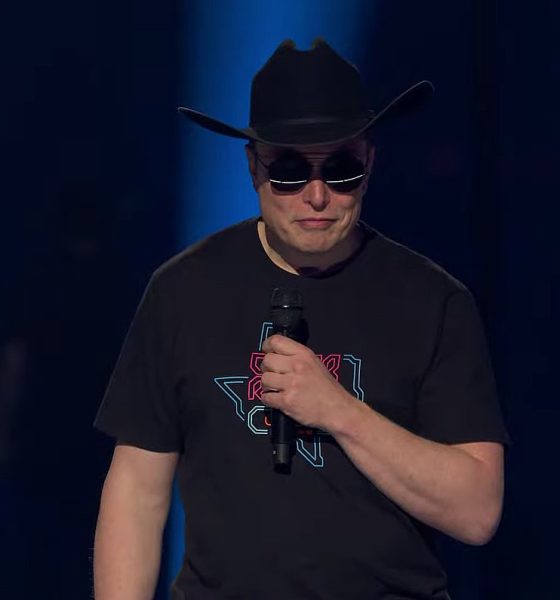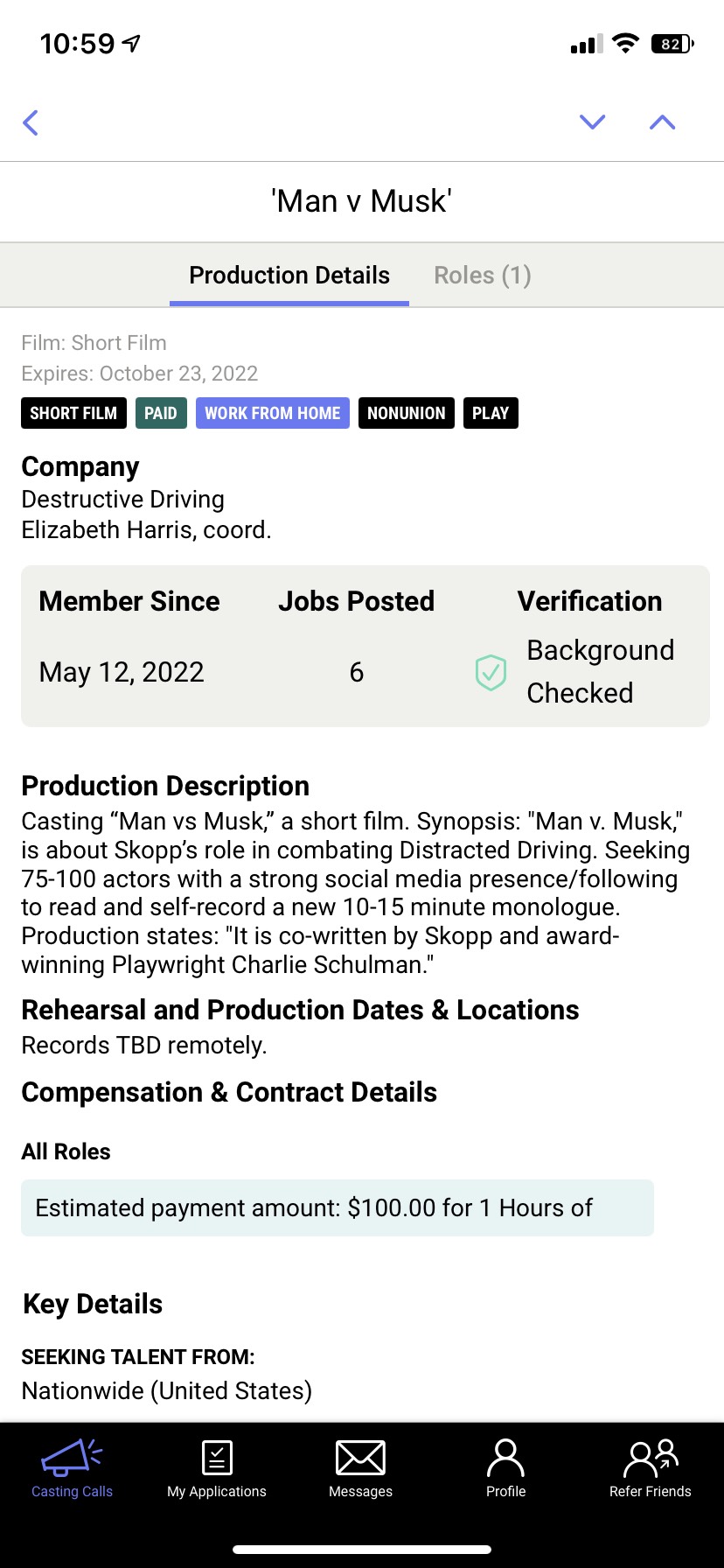

News
Filmmaker offers influencers $100 to bash Tesla, Elon Musk.
In an emailed tip sent to Teslarati, a reader shared that a filmmaker is hiring 75-100 social media influencers to record themselves bashing Elon Musk and Tesla. According to the tip, which included the screenshot below, the casting call is asking for influencers to bash Tesla, Elon Musk, and autonomous driving.

The short film, titled Man Versus. Musk, is seeking “75-100 actors with a strong social media presence/following to read and self-record a new 10-15 minute monologue.” According to the casting call, which you can find here, the pay will be a flat rate of $100 for an estimated one hour of work.
Influencers will need to record themselves reading the script and upload the video to social media before receiving the $100 payment. At the time of this writing, there are only two influencers who have read and uploaded the script which starts out as
“Hey Everybody! How’s it going? Thanks for coming. I’m Jordan. Welcome to “Man Versus Musk” A show. A comedy. A call to action. A political movement that requires our attention and focus. More on the Musk matter later,”
The script that the influencers record themselves reading claims that Elon Musk has been intentionally tone-deaf to distracted driving.
“Fact, he has built his empire disempowering drivers from the ability to pay attention and keep their car on the road,” the script reads.
According to the script, Tesla’s Ludicrous Mode is the greatest champion of distracted driving the world has ever seen. It says that Elon Musk has no interest in stopping what it calls destructive driving which would require drivers not to play on their phones while driving and change their behavior while behind the wheel.
“He is the billionaire promoter of distracted driving. He’s built his wealth and reputation on the promise of the self-driving car. Over and over, Musk has declared that truly autonomous driving is nearly here! The day when a Tesla could drive itself — which it turns out is much further away than previous estimations. Extolling the virtues of auto-pilot, leading drivers to falsely believe that it is safe to keep their eyes off the road,” the script reads.
It should be noted that Tesla has always emphasized that drivers pay attention and be prepared to take over when Autopilot and FSD Beta are engaged.
My 2.5¢
As someone who has actually met Elon Musk, witnessed FSD Beta stop for cyclists and pedestrians, and has interviewed Tesla owners and read stories by owners whose lives have been saved by their cars, I find this film lacking in facts.
I think the filmmaker does want to do good and see themself as doing good, but their actions are based upon misinformation and quite frankly, Tesla FUD (fear, uncertainty, and doubt) that is often spread by the mainstream media.
I think the focus should be on distracted driving and include facts and statistics such as the National Highway Traffic Safety Administration’s (NHTSA) recent estimates of the fatality rate per 100 million vehicle miles traveled (VMT) and compare those with Tesla’s own data.
According to the NHTSA, in 2021 there were a total of 38,824 fatalities per 100 million VMT. Tesla published its own vehicle safety report for 2021 for each quarter and includes data showing whether or not a vehicle had Autopilot engaged. According to Tesla per quarter:
Q1 2021
- 1 accident for every 4.19 million miles driven with Autopilot engaged.
- 1 accident for every 2.05 million miles driven without Autopilot engaged but with Tesla’s active safety features.
- 1 accident for every 978,000 miles driven without Autopilot and without Tesla’s active safety features.
Q2 2021
- 1 accident for every 4.41 million miles driven with Autopilot engaged and Tesla’s active safety features engaged.
- 1 accident for every 1.2 million miles driven without Autopilot and without Tesla’s active safety features.
Q3 2021
- 1 accident for every 4.97 million miles driven with Autopilot engaged and Tesla’s active safety features engaged.
- 1 accident for every 1.6 million miles driven without Autopilot and without Tesla’s active safety features.
Q4 2021
- 1 accident for every 4.31 million miles driven with Autopilot engaged and Tesla’s active safety features engaged.
- 1 accident for every 1.59 million miles driven without Autopilot and without Tesla’s active safety features.
For each quarter, Tesla said,
“By comparison, NHTSA’s most recent data shows that in the United States there is an automobile crash every 484,000 miles.”
Although Tesla documented accidents and the NHTSA documented fatalities, Tesla’s numbers show that with its Autopilot and active safety features engaged, there are fewer incidents than without.
Personally, I find it sad and disheartening that this filmmaker isn’t using facts or data and is manipulating young people into spreading misinformation about Tesla, Elon Musk, and autonomous driving for an easy $100.
Note: Johnna is a Tesla shareholder and supports its mission.
Your feedback is important. If you have any comments, or concerns, or see a typo, you can email me at johnna@teslarati.com. You can also reach me on Twitter at @JohnnaCrider1.
Teslarati is now on TikTok. Follow us for interactive news & more.

Elon Musk
Elon Musk and Tesla AI Director share insights after empty driver seat Robotaxi rides
The executives’ unoccupied tests hint at the rapid progress of Tesla’s unsupervised Robotaxi efforts.

Tesla CEO Elon Musk and AI Director Ashok Elluswamy celebrated Christmas Eve by sharing personal experiences with Robotaxi vehicles that had no safety monitor or occupant in the driver’s seat. Musk described the system’s “perfect driving” around Austin, while Elluswamy posted video from the back seat, calling it “an amazing experience.”
The executives’ unoccupied tests hint at the rapid progress of Tesla’s unsupervised Robotaxi efforts.
Elon and Ashok’s firsthand Robotaxi insights
Prior to Musk and the Tesla AI Director’s posts, sightings of unmanned Teslas navigating public roads were widely shared on social media. One such vehicle was spotted in Austin, Texas, which Elon Musk acknowleged by stating that “Testing is underway with no occupants in the car.”
Based on his Christmas Eve post, Musk seemed to have tested an unmanned Tesla himself. “A Tesla with no safety monitor in the car and me sitting in the passenger seat took me all around Austin on Sunday with perfect driving,” Musk wrote in his post.
Elluswamy responded with a 2-minute video showing himself in the rear of an unmanned Tesla. The video featured the vehicle’s empty front seats, as well as its smooth handling through real-world traffic. He captioned his video with the words, “It’s an amazing experience!”
Towards Unsupervised operations
During an xAI Hackathon earlier this month, Elon Musk mentioned that Tesla owed be removing Safety Monitors from its Robotaxis in Austin in just three weeks. “Unsupervised is pretty much solved at this point. So there will be Tesla Robotaxis operating in Austin with no one in them. Not even anyone in the passenger seat in about three weeks,” he said. Musk echoed similar estimates at the 2025 Annual Shareholder Meeting and the Q3 2025 earnings call.
Considering the insights that were posted Musk and Elluswamy, it does appear that Tesla is working hard towards operating its Robotaxis with no safety monitors. This is quite impressive considering that the service was launched just earlier this year.
Elon Musk
Starlink passes 9 million active customers just weeks after hitting 8 million
The milestone highlights the accelerating growth of Starlink, which has now been adding over 20,000 new users per day.

SpaceX’s Starlink satellite internet service has continued its rapid global expansion, surpassing 9 million active customers just weeks after crossing the 8 million mark.
The milestone highlights the accelerating growth of Starlink, which has now been adding over 20,000 new users per day.
9 million customers
In a post on X, SpaceX stated that Starlink now serves over 9 million active users across 155 countries, territories, and markets. The company reached 8 million customers in early November, meaning it added roughly 1 million subscribers in under seven weeks, or about 21,275 new users on average per day.
“Starlink is connecting more than 9M active customers with high-speed internet across 155 countries, territories, and many other markets,” Starlink wrote in a post on its official X account. SpaceX President Gwynne Shotwell also celebrated the milestone on X. “A huge thank you to all of our customers and congrats to the Starlink team for such an incredible product,” she wrote.
That growth rate reflects both rising demand for broadband in underserved regions and Starlink’s expanding satellite constellation, which now includes more than 9,000 low-Earth-orbit satellites designed to deliver high-speed, low-latency internet worldwide.
Starlink’s momentum
Starlink’s momentum has been building up. SpaceX reported 4.6 million Starlink customers in December 2024, followed by 7 million by August 2025, and 8 million customers in November. Independent data also suggests Starlink usage is rising sharply, with Cloudflare reporting that global web traffic from Starlink users more than doubled in 2025, as noted in an Insider report.
Starlink’s momentum is increasingly tied to SpaceX’s broader financial outlook. Elon Musk has said the satellite network is “by far” the company’s largest revenue driver, and reports suggest SpaceX may be positioning itself for an initial public offering as soon as next year, with valuations estimated as high as $1.5 trillion. Musk has also suggested in the past that Starlink could have its own IPO in the future.
News
NVIDIA Director of Robotics: Tesla FSD v14 is the first AI to pass the “Physical Turing Test”
After testing FSD v14, Fan stated that his experience with FSD felt magical at first, but it soon started to feel like a routine.

NVIDIA Director of Robotics Jim Fan has praised Tesla’s Full Self-Driving (Supervised) v14 as the first AI to pass what he described as a “Physical Turing Test.”
After testing FSD v14, Fan stated that his experience with FSD felt magical at first, but it soon started to feel like a routine. And just like smartphones today, removing it now would “actively hurt.”
Jim Fan’s hands-on FSD v14 impressions
Fan, a leading researcher in embodied AI who is currently solving Physical AI at NVIDIA and spearheading the company’s Project GR00T initiative, noted that he actually was late to the Tesla game. He was, however, one of the first to try out FSD v14.
“I was very late to own a Tesla but among the earliest to try out FSD v14. It’s perhaps the first time I experience an AI that passes the Physical Turing Test: after a long day at work, you press a button, lay back, and couldn’t tell if a neural net or a human drove you home,” Fan wrote in a post on X.
Fan added: “Despite knowing exactly how robot learning works, I still find it magical watching the steering wheel turn by itself. First it feels surreal, next it becomes routine. Then, like the smartphone, taking it away actively hurts. This is how humanity gets rewired and glued to god-like technologies.”
The Physical Turing Test
The original Turing Test was conceived by Alan Turing in 1950, and it was aimed at determining if a machine could exhibit behavior that is equivalent to or indistinguishable from a human. By focusing on text-based conversations, the original Turing Test set a high bar for natural language processing and machine learning.
This test has been passed by today’s large language models. However, the capability to converse in a humanlike manner is a completely different challenge from performing real-world problem-solving or physical interactions. Thus, Fan introduced the Physical Turing Test, which challenges AI systems to demonstrate intelligence through physical actions.
Based on Fan’s comments, Tesla has demonstrated these intelligent physical actions with FSD v14. Elon Musk agreed with the NVIDIA executive, stating in a post on X that with FSD v14, “you can sense the sentience maturing.” Musk also praised Tesla AI, calling it the best “real-world AI” today.








